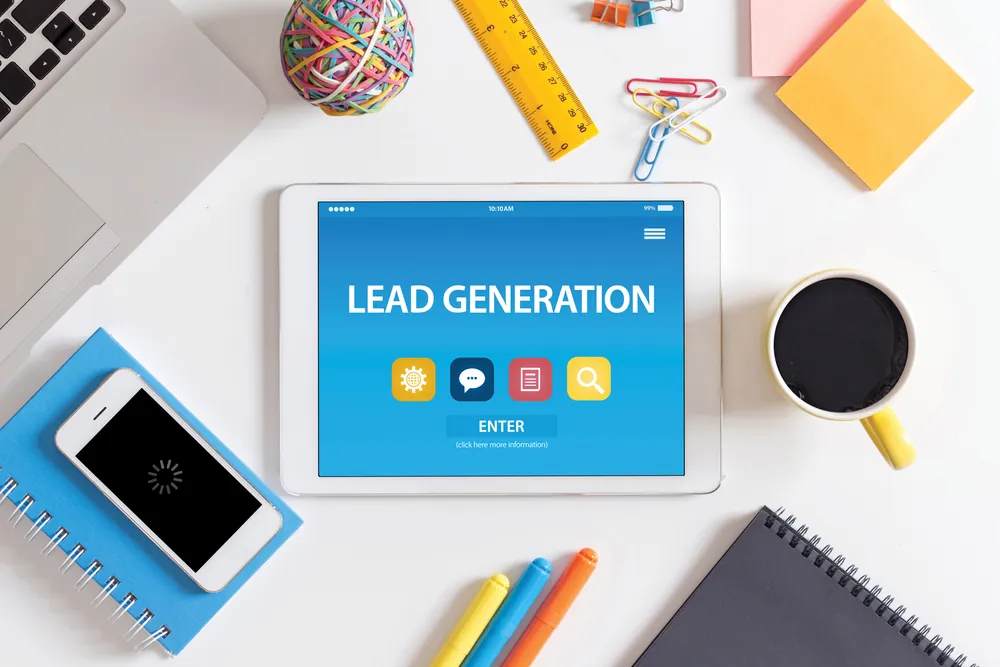Demand Gen vs. Lead Gen

One of the common challenges in B2B sales is that there’s a running list of vocabulary words used by sales teams, often interchangeably, even though there are differences in definitions. A popular example of this is demand gen vs. lead gen. Though similar and equally important to a comprehensive sales and marketing strategy, there are distinctions that will guide your approach when used in your B2B sales process.
First, let’s break down what each means. When in sales training, people usually learn jargon that is usually straightforward in its definition, which is why demand generation is what you’d expect: the concept of generating demand for your product or service. Drumming up a higher demand for your business involves raising awareness and building consumer confidence via multiple mediums. This is often achieved through content marketing efforts, including blog posts, white papers, newsletters, and video how-tos.
A marketing team can work with your sales reps to drive this content and draw in a broader audience to get more eyes on the benefits of what your team has to offer. This is done through more extensive brand awareness campaigns and through messaging to targeted audiences that meet pre-established sales criteria for prospects.
Conversely, lead generation strategy is focused on generating potential leads. When you have a successful demand generation strategy in place, the greater visibility achieved aids in acquiring more quality leads with prospects as well. These are the potential buyers who meet your qualifying criteria and are ready to buy.
Lead gen is known as the process of attracting qualified buyers and turning them into qualified opportunities. This can be achieved through product demonstrations, hosted webinars, gated content and more. Each of these requires a prospect to share contact and other identifiable information that can be lined up to what qualifies them as a good lead.
When it comes to demand generation marketing vs. lead generation marketing, it’s not an either-or situation. You need both. Demand generation campaigns are designed to reach new audience groups and constantly feed the lead pipeline. Lead gen can help turn this traffic and convert it into actual leads.
To fully gauge how to use each to your advantage in B2B sales, it’s best to explore and refine these areas of your sales funnel and learn how working with your marketing team can help drive quality leads consistently.
Demand Generation vs. Lead Gen Strategies and Campaigns
In today’s environment, demand generation and lead generation campaigns are rooted in content marketing, which creates a valuable opportunity of reaching prospects in multiple ways. The strategies involve researching your target audience, exploring the ways you’ll reach them, and measuring results.
A potential buyer often makes several touchpoints before they’re actually ready to buy. Spreading sales efforts across various content channels allows you to reach more people.
Researching Your Target Audience
Before creating content, research the kind of content your audience is interested in by putting together a buyer persona. Start by brainstorming the basics of what you know about the industry you’re trying to sell to by identifying:
- What are the problems they face?
- Where does your target audience consume content?
- How does your target audience like to consume content?
After exploring general factors pertaining to the type of content your audience engages with, dive deeper into research by reviewing data, such as online reviews or testimonials, and putting together a competitive analysis. This will provide insight on general expectations in the industry as well as specific feedback from your current customers.
Exploring Ways to Reach Your Target Audience
Managing a strong online presence through content-led efforts will help maximize your prospect efforts and increase the effectiveness of your messaging to a broader audience. Match your digital marketing efforts to answering your audience’s main challenges.
Also, ensure your content is visible where prospects are most active. For example, if your potential customer base is active on social media, you’ll want to generate a steady stream of content through targeted social media campaigns to keep them engaged.
Prioritizing where you spend your efforts will help to maximize results and reach people where they are. However, social media is just one of the many ways to reach your target audience. There’s also blogging, white papers, videos, live events, trade shows, and more. Decide which type of content is relevant to which audience and will persuade them to respond favorably.
Demand Generation Content
Demand generation content establishes awareness and builds brand authority for buyers at the top of the sales funnel. This group may be interested in your brand, products, or services but aren’t in the position to buy. This type of content should detail the benefits of your products or services, position your business as a thought leader in the industry, and be a free source of information for anyone who may benefit from what you’re selling.
Social Media
It’s no secret social media can be one of the best demand generation strategy resources there is. Not only does it allow sales teams to reach a larger audience at once, but it does so in a way that feels authentic and informative. Using social media to increase visibility and generate excitement about your products and services is a powerful tool when following a structured strategy.
Build a plan that identifies solutions to main prospect challenges, shares insightful data they’ll find useful, and highlights the value propositions your company has to offer. Determine which platform(s) makes sense for your audience by measuring viewership and engagement on a regular basis. You can then track results and modify campaigns as necessary.
Blog Posts
Blog posts can expand on ideas mentioned on social media and can build upon specific topics of interest within the industry you’re trying to target. Blogs also act as a valuable demand gen strategy that allow you to show up higher in search queries.
Perform keyword research to generate blog topic ideas and incorporate these into your content in ways that sound natural. The goal of blog posts is to educate and inspire. Share lists, how-tos, and other insightful information that cements you as a leader in the field to inspire trust and confidence.
Lead Generation Content
When it comes to demand gen vs. lead gen content, the difference is the audience it’s meant for. Lead generation content is designed for those who are further down the sales funnel. It’s targeted to answer specific questions, provide evidence of previous success (via case studies), and capture contact info for a sales follow-up. White papers and videos are great ways to deliver content that will persuade potential buyers to engage further.
White papers
White papers are an effective sales and digital marketing tool to promote lead gen when used as gated content. Host white papers on landing pages focused specifically on gathering emails. These emails can then be used for future sales purposes such as webinar invitations or newsletter signups.
White paper content is direct and informative. The goal is to highlight a solution to a common problem that prospects encounter in a detailed way. The information provided is supported by statistics and case study details that can provide evidence for the point being made.
Videos
Videos are another impactful way to attract potential leads. As with blogs, they can be used as a way to drive interest surrounding your products or services. However, they’re also a popular way to conduct product demonstrations and host webinars to get prospects closer to the buying stage.
Social media, blog posts, white papers, and videos reflect many of the ways to drive interest in your products and services. To gauge which methods work best for your sales team, review analytics of each as you implement them into your sales strategy. It will allow you to prioritize time and budget to optimize effectiveness.

Measuring Demand Gen Results
By better understanding your target audience, the kind of content they’re responding to, and which methods are driving quality leads, you can refine your demand and lead gen strategies and campaigns going forward. Set KPIs for each effort to measure against month-after-month (or more frequently, depending on the medium and budget). Common KPIs to monitor are:
- Number of blog post and/or video views
- Percentage of social media engagement
- Number of white paper downloads
- New emails acquired
- Number of direct conversions
This type of data guides which topics, strategies, and campaigns are most relevant and successful.
Where Does Each Strategy Fit Into the Sales Process?
Comparing demand gen vs. lead gen efforts is part of what’s necessary to monitor the impact of your B2B sales process. Both of these methods involve applying research, establishing credibility, and speaking to consumer challenges. Through the various content published, you’re continuously providing solutions and making connections among your target audience base. This will aid in driving leads and, eventually, more secured deals.
Demand generation marketing strategies allow you to reach a large audience with impactful messaging in various ways. The goal is to raise visibility for your online presence, solidify you as a thought leader, and keep your business front-of-mind. Because of this, it fits well into the research and prospecting part of the sales process.
Lead generation strategies allow easier access to set up a first sales consultation or product demo to interested parties. It keeps the sales pipeline full of qualified leads that you can move through the sales process. Determine where these leads are in the sales funnel, and customize the approach based on their interest level. It will help you close more deals and build better long-term client relationships.
At Janek, we’re well-versed in B2B sales and can educate you on the tools, techniques, and strategies necessary to succeed in your B2B sales process.
Identifying what prospects want and what they need to overcome their challenges will guide your sales efforts. Provide information that supports your solutions and shows validity in their success. These ongoing demand generation and lead generation efforts drive engagement for qualified leads and constantly connect with new prospects.

- Account Planning (12)
- Awards (44)
- Client Testimonial (37)
- Personal Branding (21)
- Podcast (12)
- Research (78)
- Sales Career Development (90)
- Sales Coaching (166)
- Sales Consulting (141)
- Sales Culture (180)
- Sales Enablement (382)
- Sales Leadership (116)
- Sales Management (267)
- Sales Negotiation (14)
- Sales Prospecting (138)
- Sales Role-Playing (19)
- Sales Training (243)
- Selling Strategies (281)
- Soft Skills (78)
- Talent Management (101)
- Trusted Advisor (29)
- Virtual Selling (57)
- Webinar (13)

























